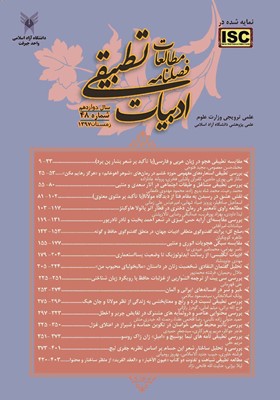خیر و شر در افسانههای ایرانی و آلمانی
محورهای موضوعی : شعرپولک اصلانخانی 1 , سیدمسعود سلامی 2
1 - دانشجوی دکتری زبان و ادبیات آلمانی، دانشگاه آزاد اسلامی واحد علوم و تحقیقات تهران- ایران
2 - عضو هیأت علمی گروه زبان و ادبیات آلمانی دانشگاه آزاد اسلامی واحد علوم و تحقیقات تهران- ایران
کلید واژه:
چکیده مقاله :
افسانهها که از ارکان مهم ادبیات همه اقوام در سراسر دنیا به شمار میروند، با زبانی سمبولیک و در قالب داستانهایی خارق العاده ارزشهای اجتماعی و فرهنگی ملتها را به تصویر میکشند و بدین ترتیب از منابع مهم تحقیق در زمینههای اجتماعی و فرهنگی محسوب شوند. با بررسی تطبیقی قصهها از یک سو میتوان به اندیشه و تفکری که پایه و اساس آنهاست پی برد و از سوی دیگر مسائل مشترک اقوام و ملل سراسر دنیا را روشن کرد. از مهمترین و برجستهترین انواع افسانه، افسانههای جادویی یا قصههای پریان هستند که حوادث و رویدادهای خارق العاده و ماورای طبیعی را در جهانی غیر واقعی و خیالی به تصویر میکشند. از آنجا که دوگانگی از ارکان مهم افسانههای جادویی و از موتیفهای اصلی قصههای پریان محسوب میشود، لذا بررسی تطبیقی این عنصر و نیز نقش قهرمان در تقابل خیر و شر در افسانههای ایرانی و آلمانی، جهت روشن کردن تشابهات و تفاوتهای دو فرهنگ، از اهداف مهم تحقیق پیش رو است.
Myth, which is one of the major building blocks of literature throughout the world, portrays through symbolic language exquisite stories of social and cultural values of the nations, and is considered as significant sources of social and cultural research. By comparative analysis of tales, the thought and the bases of them are recognized from one hand and it is feasible to find the common grounds of nations throughout the world on the other. Magical tales and fairy tales are among the most important and marvelous myths which present extraordinary and metaphysical incidents in unreal and imaginary worlds. Since duality is a vital basis of magical myths and is among major motives in fairy tales, the aim of this study is to comparatively analyze this factor and also the role of the protagonist in confrontation with vice and virtue in Germanic and Iranian myths to highlight the similarities and differences of the two cultures.
نهج البلاغه، ترجمه محمد دشتی.
کتب فارسی
بهار، مهرداد. 1384 ش، از اسطوره تا تاریخ(با تجدید نظر و افزودههای تازه)، گردآورنده: ابوالقاسم اسماعیل پور، چاپ چهارم، تهران: نشر چشمه.
بهار، مهرداد. 1386 ش، ادیان آسیایی، چاپ ششم، تهران: نشر چشمه.
خدیش، پگاه. 1391 ش، ریختشناسی افسانههای جادویی، چاپ دوم، تهران: شرکت انتشارات علمی و فرهنگی.
قاسم زاده، محمد. 1392 ش، افسانههای ایرانی، جلد اول و دوم، چاپ دوم، تهران: انتشارات هیرمند.
گریم، یا کوب لودویگ کارل. 1384 ش، مجموعه کامل قصهها و افسانههای برادران گریم، ترجمه هرمز ریاحی، نسرین طباطبایی، بهزاد برکت، چاپ دوم، تهران: نشر پیکان.
مارزلف، اولریش.1391 ش، طبقه بندی قصههای ایرانی، ترجمه کیکاووس جهانداری، چاپ سوم، تهران: انتشارات سروش.
مختاری، محمد. 1379 ش، حماسه در رمز و راز ملی، چاپ دوم، تهران: انتشارات توس.
میر صادقی، جمال. 1390 ش، ادبیات داستانی، چاپ ششم، تهران: انتشارات سخن.
کتب آلمانی
Bettelheim, Bruno (2013), Kinder brauchen Märchen, 32. Auflage, München: Deutscher Tashenbuch Verlag.
Dickmann, Axel (2014), Grimms Märchen von A bis Z: Kleines Lexikon der Märchenmotive, 1. Auflage, Norderstedt: Books on Demand Verlag.
Lüthi, Max (2004), Märchen, Zehnte Auflage, Stuttgart: J.B. Metzler Verlag.
Lüthi, Max (2005), Das europäische Volksmärchen, Elfte Auflage, Tübingen: A. Francke Verlag.
Risi, Armin (2015), Unterscheiden, ohne zu urteilen – Was bedeutet das?, http://armin-risi.ch/Artikel/Philosophie/Unterscheiden_ohne_zu_urteilen.html.
Volkstümliche Erzählungen aus dem Iran (2016), http://german.irib.ir/radio-culture/literatur/
_||_
Nahj al-Balagha, Translator Mohammad Dashti.
Persian Bibliography
Bahar, Mehrdad (1386), Asian Religions, Sixth Edition, Tehran: Cheshmeh.
Bahar, Mehrdad (1384), From Mythos to History (with editorial revision and new additions), Collector: Abolghasem Esmaeilpour, Fourth Edition, Tehran: Cheshmeh.
Ghasem Zadeh, Mohammad (1392), Iranian Folktales, first and second Bands, Second Edition, Tehran: Hirmand.
Grimm, Wilhelm Karl (1384), The Complete Grimm’s Fairy Tales, Translator: Riahi, Hormoz, Tabatabei, Nasrin, Barkat, Behzad, Second Edition, Tehran: Peykan.
Khadish, Pegah (1391), Morphology of Folktales, Second Edition, Tehran: Elmi & Farhangi.
Marzolph, Ulrich (1391), Typology of Persian Folk Tales, Translator Keykavous Jahandari, Third Edition, Tehran: Soroush.
Mirsadeghi, Jamal (1390), Fiction, Sixth Edition, Tehran: Sokhan.
Mokhtari, Mohammad (1379), Epic poetryin national Mystery, Second Edition, Tehran: Toos.
German Bibliography
Bettelheim, Bruno (2013), Children need fairy tales, 32. Edition, Munich: Deutscher Tashenbuch Verlag (dtv Verlaggeselschaft).
Dickmann, Axel (2014), Grimm‘s Fairy Tales from A to Z: Little Lexicon of Fairy Tale Motifs, First Edition, Norderstedt: Books on Demand GmbH.
Lüthi, Max (2004), Fairy Tale, tenth Edition, Stuttgart: J.B. Metzler.
Lüthi, Max (2005), European Fairy Tales, eleventh edition, Tübingen: A. Francke.
Risi, Armin (2015), Distinguish, distinguish without judgement – What does it mean? http://armin-risi.ch/Artikel/Philosophie/Unterscheiden_ohne_zu_urteilen.html
Folk Stories from Iran (2016),http://german.irib.ir/radio-culture/literatur/.


